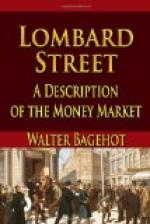’Experience, as shown by plain figures, confirms these conclusions. We print at the end of this article the respective profits of 110 banks in England, and Scotland, and Ireland, being all in those countries of which we have sufficient information—the Bank of England excepted. There are no doubt others, but they are not quoted even on local Stock Exchange lists, and in most cases publish no reports. The result of these banks, as regards the dividends they pay, is—
No. of Companies Capital L Above 20 per cent 15 5,302,767 Between 15 and 20 per cent 20 5,439,439 10 and 15 per cent 36 14,056,950 5 and 10 per cent 36 14,182,379 Under 5 per cent 3 1,350,000 110 40,331,535
that is to say, above 25 per cent of the capital employed in these banks pays over 15 per cent, and 62 1/2 per cent of the capital pays more than 10 per cent. So striking a result is not to be shown in any other joint stock trade.
’The period to which these accounts refer was certainly not a particularly profitable oneon the contrary, it has been specially unprofitable. The rate of interest has been very low, and the amount of good security in the market small. Many banks—to some extent most banks—probably had in their books painful reminiscences of 1866. The fever of excitement which passed over the nation was strongest in the classes to whom banks lent most, and consequently the losses of even the most careful banks (save of those in rural and sheltered situations) were probably greater than usual. But even tried by this very unfavourable test banking is a trade profitable far beyond the average of trades.
’There is no attempt in these banks on the whole and as a rule to divide too muchon the contrary, they have accumulated about 13,000,000 L., or nearly 1/3 rd of their capital, principally out of undivided profits. The directors of some of them have been anxious to put away as much as possible and to divide as little as possible.
’The reason is plain; out of the banks which pay more than 20 per cent, all but one were old-established banks, and all those paying between 15 and 20 per cent were old banks too. The “privileged opportunity” of which we spoke is singularly conspicuous in such figures; it enables banks to pay much, which without it would not have paid much. The amount of the profit is clearly proportional to the value of the “privileged opportunity.” All the banks which pay above 20 per cent, save one, are banks more than 25 years old; all those which pay between 15 and 20 are so too. A new bank could not make these profits, or even by its competition much reduce these profits; in attempting to do so, it would simply ruin itself. Not possessing the accumulated credit of years, it would have to wind up before it attained that credit.
’The value of the opportunity too is proportioned to what has to be paid for it. Some old banks have to pay interest for all their money; some have much for which they pay nothing. Those who give much to their customers have of course less left for their shareholders. Thus Scotland, where there is always a daily interest, has no bank in the lists paying over 15 per cent. The profits of Scotch banks run thus:




